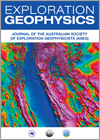
Exploration Geophysics
Volume 49 Number 2 2018
EG15072Noise removal for airborne time domain electromagnetic data based on minimum noise fraction
Residual noise remains in airborne time domain electromagnetic profiles after preprocessing the data, and this noise affects the exploration of targets. An approach to reduce this noise based on the minimum noise fraction has been proposed in this paper.
EG16139Trans-dimensional Bayesian inversion of airborne electromagnetic data for 2D conductivity profiles
We apply a novel trans-dimensional Bayesian approach using a wavelet parameterisation to airborne electromagnetic (AEM) inversions using data from the Broken Hill region. This approach allows exploration of a range of plausible subsurface conductivity models and provides more robust uncertainty estimates while accounting for potential non-uniqueness.
EG16057Investigating subsurface structures of Gachsaran oil field in Iran using 2D inversion of magnetotelluric data
In 2012, the National Iranian Oil Company conducted an electromagnetic survey in the Gachsaran oil field. The Bahr’s skew and Mohr diagrams were used to perform the dimensionality analysis. Magnetotelluric data were modelled using the smoothness-constrained least-squares method. The resulting model revealed the main anticline and overthrust zone in the region.
EG16044MOPSO: a new computing algorithm for joint inversion of Rayleigh wave dispersion curve and refraction traveltimes
This study introduces the multi-objective particle swarm optimisation (MOPSO) strategy as a new tool for joint inversion of Rayleigh wave dispersion curve and refraction traveltimes. The proposed algorithm was tested on two synthetic datasets and an experimental dataset. The results showed that the applied joint inversion technique can considerably reduce uncertainties of the inverted models.
EG16136Comparative analyses of seismic site conditions and microzonation of the major cities in Gangwon Province, Korea
To determine the seismic site conditions and microzonation of Chuncheon, Wonju, and Gangneung in Korea, shear-wave velocities were derived at 313 sites by the ESPAC method. The proxy-based Vs30 indicated that these cities were mainly categorised into NEHRP classes B, C, and D, with a minor proportion of A.
EG16094An implicit spatial and high-order temporal finite difference scheme for 2D acoustic modelling
We propose a new finite difference (FD) scheme that is implicit in space (adopting the Taylor-expansion-based or least-square based FD coefficients) and has high-order accuracy in time (adopting a combination of rhombus and cross stencils). Dispersion analysis, stability analysis and modelling examples validate the superiority of our method.
EG16116Modified interferometric imaging condition for reverse-time migration
The artefacts caused by random fluctuations in the background velocity model will contaminate the final image, which makes the work of interpretation difficult to implement in reverse-time migration. The imaging condition proposed in this paper, which exploits the pseudo-Wigner distribution function, can reduce this noise, and also help improve the continuity of complex layers.
EG16111Adaptive phase k-means algorithm for waveform classification
To alleviate the effect of phase in waveform classification, the adaptive phase k-means is introduced for unsupervised seismic facies analysis. This method improves the traditional k-means algorithm by using an adaptive phase distance for waveform similarity measure, and is thus robust to phase variations caused by horizon interpretation.
EG16022Subsurface attenuation estimation using a novel hybrid method based on FWE function and power spectrum
A new Q estimation approach, called improved frequency weighted exponential (IFWE), is presented by combining the advantage of the FWE method and the power spectrum. Tests of synthetic and field data show that the IFWE is more robust and the bandwidth selection for the IFWE is more tolerant than the FWE.
EG17019Investigation of the line arrangement of 2D resistivity surveys for 3D inversion
We have conducted numerical and field experiments to investigate the applicability of electrode configurations and line layouts commonly used for 2D resistivity surveys to 3D inversion. We propose that parallel lines are useful to highlight areas of particular interest where further detailed work with an intersecting line could be carried out.

